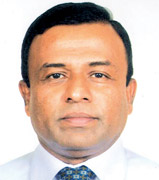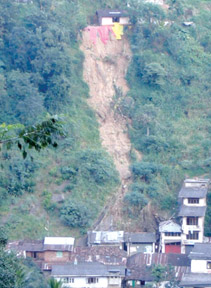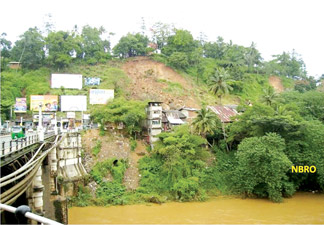Construction disallowed in high hazard zones
By Mohammed NAALIR
|

R.M.S. Bandara, Head, Landslides Studies and services Division
|
|

Padiyapelella landslide |
Improper land use and construction at bad sites have given rise to
landslides. Colombo and Gampaha districts have come into the landslide
zones, said, R.M.S. Bandara, Head, Landslide Studies and Services
Division, National Building Research Organisation (NBRO).
He said that these were not landslides in real terms. It is known as
cutting failure, what happens is during heavy rains the unstable
soil-marsh begins to get loose.
The surveys of NBRO have identified that Badulla, Nuwara-Eliya,
Kandy, Matale, Kegalle, Ratnapura, Kalutara, Galle, Matara and
Hambantota districts are vulnerable to landslide. The Organisation has
categorised land into four zones such as high, medium and low hazards,
and safe zones.
"Constructions should not be carried out in high hazard zones. There
is no major threat in medium and low hazard zones", he said.
Bandara said that over 40 per cent of the people were negligent and
did not obtain land clearance certificates from the NBRO. "Its
recommendation and approval are crucial" he said. This, he emphasised
was essential so that constructions will not be carried out in unsafe
areas.
According to the Disaster Management office, there are 2,103 houses
in landslide-prone areas in the Nuwara-Eliya district. Eighty among
which are in the high hazard zones. In the Badulla district 60 out of
250 families live in the landslide prone areas in high hazard zones.
Rainfall variations, geological and hydrological settings are the
part of the natural reasons, and improper cutting of soil is the main
man-made change. Bad land use practices will also lead to landslides.
|

Peradeniya landslide |
Several places vulnerable to landslides have been identified in the
Kandy and Badulla districts. Specially the hospital area in Kandy and
the Haldumulla town in the Badulla district. Both are different in
nature. Haldumulla being a landslide prone area, is a natural occurrence
while the Kandy hospital area is a man-made change.
There is a big escapement covered with unstable soil-marsh and rock
in Haldumulla. There is a grave risk that the soil-marsh will fall at
any time due to heavy rains.
Bandara said from time to time the NBRO reported minor incidents. The
NBRO recommends that Haldumulla town must be relocated in order to avoid
a major calamity.
In Kandy, the nurses quarters, training school and hospital come
under the hazard zone. The landslide threat is increasing in this area.
There is a land cut of over 10 metres in height in the direction of
Bogambara stadium. Mitigation program has to be conducted immediately,
if a calamity is to be averted.
The NBRO has sought financial assistance from the Government. No
sooner it receives funds, mitigation work on this site will commence.
Last year the Secretary of Disaster Management Ministry issued a
circular stating that no new construction can be carried out without
authorisation from the NBRO. Meanwhile he alleged that new constructions
were taking place with the authorisation of Local Government authorities
without the approval from NBRO.
After receiving details of a site, NBRO experts visit and have a
thorough study of the site. Granting permission or rejection will depend
on the condition of the soil and other requirements of the Organisation.
At no time will permission be granted to a vulnerable site.
This procedure is in effect in landslide prone districts.
The NBRO has set up field stations in these districts. Considerable
time will be taken to issue a guarantee certificate to constructors, as
the soil has to be checked. We have been given only three weeks time. A
perfect authorisation certificate cannot be issued in this time frame.
The people must realise the fact that soil experiments are for the
safety of the people, not to obstruct construction. All must think
positively and should cooperate with the authorities.
The NBRO has mapped out the high hazard zones. Nuwara-Eliya, Kandy,
Kegalle and Ratnapura districts come under the high hazard zone.
In certain areas including Kandy, the people neglect the instructions
of the authorities and continue constructions at places prone to
landslides. They are creating problems for themselves.
That is the problem the NBRO is facing now. Permission will not be
granted to places that are prone to landslides.
Eventhough the NBRO rejected the proposals, certain people use
influence to get their work done.
Landslide Division Head said that people must think of future risks
and threats. When the NBRO reject a proposal there is a strong reason
behind it. Several factors are connected with safe construction, such as
mitigating and Improving land, developing and controlling the drainage
system.
The slope of land and proper drainage system must be taken in to
consideration in the planning process.
In the case of new constructions, pillars must be laid from the rock.
Those are the things to be considered. Then only a threat-free house
can be constructed.
With a view to mitigating landslides the NBRO is conducting awareness
programs in the threat prevailing districts. The first series of
awareness campaign was conducted for politicians. It was followed by a
campaign for technical officers.
Now the NBRO is focusing attention on engineers, architects and other
professionals engaged in the construction industry. A mega awareness
program will be conducted for the public in those districts next year.
The NBRO is awaiting for funds.
A poster and booklet distribution campaign on landslides will also be
conducted. The NBRO is working out plans to start this program.
Posters will be displayed in Grama Niladari offices while
distributing books to public.
Bandara said that amidst criticism by various factions the Peradeniya
land-slide mitigation project is nearing completion. It will be
completed before the end of this month.
He expressed confidence that construction of proper drainage system
in an efficient manner will help mitigate landslide. Studies have
revealed that improper drainage system was the major reason for
landslides in Sri Lanka as much water has been retained underground.
Bandara expressed confidence that if water can be removed
systematically a large number of landslides can be averted.
Two landslides occurred in Watawala in 1992 and 1993. A proper
drainage system was constructed in the area. Not a single land-slide was
reported. Beragala and Pussellawa are other examples.
w"We can't neglect the high hazard zones because the country is
small," said Bandara elaborating that the institute is trying to find
methods to re-use high hazard zones.
Landslides claim thousands of lives worldwide every year. It accounts
for between 25 to 50 in the United states. Sixteen persons were killed
in the San Bernardino in December 2003, California.ri Lanka is not an
exception for landslide.
|

